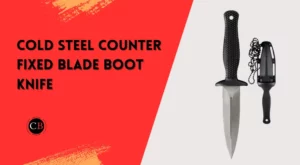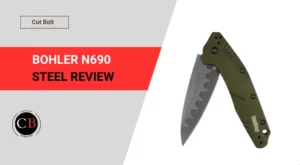Ever heard of CTS BD1 steel and wondered if it stacks up for your next trusty blade? Knife enthusiasts, read my CTS BD1 steel review! This in-depth review dives into the heart of CTS BD1, analyzing its strengths, weaknesses, and whether it deserves a spot in your pocket.
Whether you’re a seasoned collector or a curious newcomer, we’ll uncover everything you need to know:
Edge Retention: Can it stay sharp through those demanding tasks?
Toughness: Does it bend or break when things get rough?
Sharpening Ease: Are you ready for effortless touch-ups or a sharpening marathon?
Corrosion Resistance: Will it rust if you forget it after a rainy adventure?
Value for Money: Does it offer bang for your buck compared to other steels?
Plus, we’ll compare it to popular contenders like S30V and VG-10, giving you a clear picture of how CTS BD1 measures up. So, buckle up and get ready to discover if CTS BD1 steel is the hidden gem waiting to be unleashed in your collection!
- What is CTS BD1 steel?
- CTS BD1 steel chemical composition
- What is the hardness of CTS BD1 steel?
- How to heat treat CTS BD1 steel?
- CTS BD1 steel properties
- Is CTS BD1 steel a rust-free steel or a stainless steel?
- What steel is similar to CTS BD1?
- CTS BD1 vs other popular Steel
- Final Words: CTS BD1 steel review
What is CTS BD1 steel?
CTS BD1 steel is a low-end vacuum-melted American stainless steel known for its balanced performance at an affordable price. At Spyderco’s request, Carpenter specifically designed the CTS-BD1 steel to be an American equivalent of the renowned Hitachi “Gingami I” (silver paper), used in earlier Spyderco knives as G2 and currently known as GIN 1.
It offers good edge retention, corrosion resistance, and machinability, making it a popular choice for both budget-conscious and performance-oriented knife users. Its industrial applications in ball bearings and machinery parts further highlight its durability and ability to handle high wear conditions.
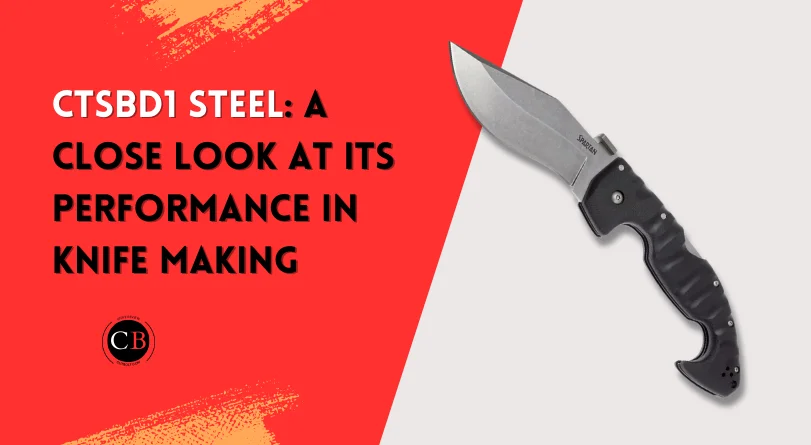
CTS BD1 steel chemical composition
The chemical composition of CTS BD1 is a blend of high chromium and moderate carbon (0.9%), which gives the steel wear resistance and corrosion resistance.
| Element | Portion | Effect |
| Chrome | 15.75% | Improves wear resistance, heat resistance and scale resistance. It increases tensile strength because it acts as a carbide former. Use of rust-proof or stainless steel, as it increases corrosion resistance from a mass proportion of 12.2%. Reduction in weldability. |
| Carbon | 0.90% | Increasing hardness and tensile strength. In larger quantities, increase in brittleness and reduction in forgeability and weldability. |
| Manganese | 0.60% | Improves hardness and tensile strength. |
| Molybdenum | 0.30% | Improves hardenability, tensile strength and weldability. Reduction in forgeability and ductility. |
| Silicon | 0.37% | Improves strength. |
| Vanadium | 0.10% | Increasing hardness, increasing wear resistance and improving tempering resistance. |
What is the hardness of CTS BD1 steel?
According to Carpenter, the maximum hardness of CTS BD1 is 58-60 HRC. (see data sheet here). The hardness of CTS BD1 in comparison:
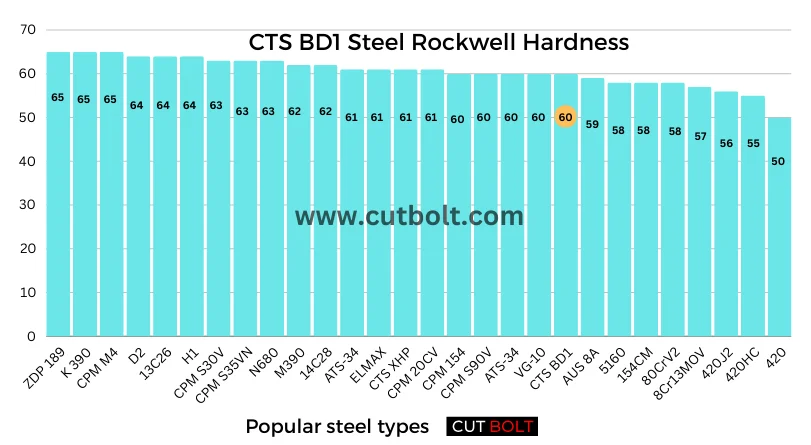
How to heat treat CTS BD1 steel?
Here are the CTS BD1 steel heat treatment steps:
Annealing
To achieve maximum softness, this steel should be heated uniformly to 1550/1600°F (843/871°C). Soak the steel and cool it very slowly in the furnace. The Brinell hardness will be approximately 223. For an intermediate or process anneal, heat the steel uniformly to 1350/1400°F (732/760°C). Air cool. Brinell hardness will be approximately 241.
Hardening
Heat to 1850/1950°F (1010/1066°C); soak; quench in warm oil or air-cool thin sections. Do not overheat. Full hardness cannot be achieved if overheated.
Tempering
To eliminate stress peaks and still maintain maximum hardness, temper at 300/350°F (149/177°C) for at least one hour. A hardness of approximately Rockwell C 58/59 is achieved.
Tempering behavior of the CTS BD1 alloy
| Tempering, 1 hour | Hardness HRC^ 1850 °F/1010 °C | Hardness HRC^ 1900 °F/1038 °C | Hardness HRC^ 1950 °F/1066 °C |
| 300 °F/149 °C | 57 | 58 | 60 |
| 400 °F/204 °C | 55 | 55 | 57 |
| 500 °F/260 °C | 54 | 55 | 55 |
| 600 °F/316 °C | 54 | 54 | 55 |
| 700 °F/371 °C | 54 | 55 | 55 |
| 800 °F/427 °C | 54 | 55 | 56 |
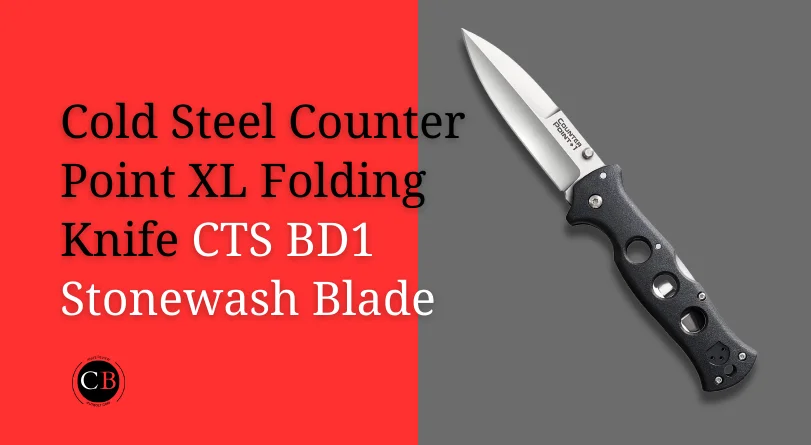
Related: Is CTS XHP a good knife steel?
CTS BD1 steel properties
From the chemical composition table above, it is easy to see the properties of a CTS-BD1 knife.
Edge retention
CTS-BD1 stands out amongst its budget-friendly peers like AUS-8 and 8Cr13MoV. Boasting exceptional edge retention, this steel doesn’t shy away from demanding tasks.
The key?
It has impressive hardness. Instead of rolling or losing its form with use, CTS-BD1 bites down hard, holding its edge for longer cuts and cleaner results. So, say goodbye to frequent sharpening sessions and hello to a blade that stays keen and reliable.
Corrosion resistance
Budget Bite with Bite-Proof Protection: CTS-BD1 punches above its weight with corrosion resistance rivaling pricier steels, thanks to its chromium-packed punch (15.75%). While not totally rust-proof, it tackles everyday moisture with ease. Just give it a quick wipe after use, and it’ll stay sharp and shiny.
Strengths:
- High chromium content: Around 15.75%, which is sufficient for resisting rust in mild environments like fresh water, steam, and some organic materials.
- Comparable to popular budget steels: Offers similar corrosion resistance to other commonly used options like AUS-8 and 8Cr13MoV.
Weaknesses:
- Not perfect: Can still rust if exposed to salty environments, acidic food, or prolonged wet conditions without proper care.
- Temper affects resistance: Lower tempering temperatures (below 800°F) generally enhance corrosion resistance, while higher tempering prioritizes other properties.
Overall:
CTS BD1 is a decent choice for everyday carry knives where you encounter primarily mild environments.
However, if frequent exposure to harsh conditions is expected, other steels with superior corrosion resistance might be better suited.
Wear resistance
The carbon and chromium combination makes CTS BD1 steel known for its wear resistance and robustness.
However, you should know its positives and negatives;
Positives:
- Higher hardness: With a Rockwell C hardness of 58-60, CTS BD1 resists wear better than average steels, handling most everyday cutting tasks like food, cardboard, and light wood without issue.
- Robust composition: The combination of chromium, carbon, and other elements contributes to its durability, even finding applications in ball bearings and machinery parts.
Nuances:
- Mid-range performance: Compared to top-tier wear-resistant steels like S30V or M390, CTS BD1 experiences slightly faster dulling under intense or prolonged use.
- Susceptible to scratches: Its hardness can make it more prone to micro-scratches compared to softer steels.
Sharpness
Sharpen up! CTS BD1 takes a fine edge, slicing cleanly thanks to its high hardness. Unlike some high-end steels, it sharpens easily, keeping your blade keen without fancy tools.
However, remember: “good” doesn’t mean “the best”. Under tough conditions, its edge won’t stay razor-sharp forever. Think about everyday tasks and moderate cutting – for heavy-duty jobs, you might need a steel built for endurance.
Toughness
CTS BD1 strikes a balance when it comes to toughness. It’s no pushover, able to handle bumps and bruises that would leave softer steels whimpering.
Picture batoning firewood or prying open a stuck lid – it won’t chip or snap easily. However, it’s not the ultimate tank. Think of it as a reliable workhorse, not a superhero.
For extreme abuse or heavy impacts, consider steels specifically designed for ultimate toughness. Remember, striking a rock with any knife is a gamble, no matter the steel.

Is CTS BD1 steel a rust-free steel or a stainless steel?
Yes, CTS BD1 steel is rust-free and stainless steel. CTS BD1 boasts strong corrosion resistance thanks to its chromium content exceeding 10.5%, surpassing the common threshold for stainless steel classification.
Additionally, its low sulfur and phosphorus levels fall within the typical range for stainless steels, further confirming its classification. So, theoretically, CTS BD1 is both rust-free and stainless steel. It offers excellent protection against corrosion in regular use with proper care.
What steel is similar to CTS BD1?
CTS BD1 punches above its weight class, offering both good corrosion resistance and wear resistance at a budget-friendly price. This puts it up against mid-range contenders like VG10.
Both steels boast impressive edge retention, although CTS BD1 wins in the sharpening ease department.
Their toughness sits comfortably in the “reliable” zone, and their price tags are comparable. VG-10 might hold a slight edge in popularity thanks to its widespread use in kitchen knives, but CTS BD1 offers a compelling alternative for those seeking value and performance.
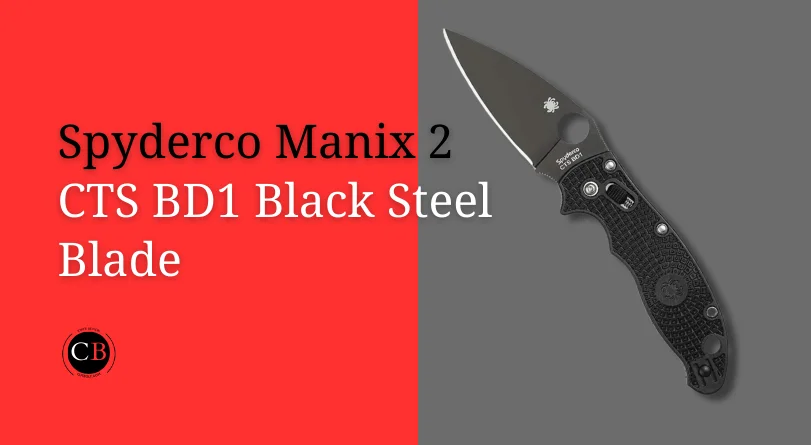
CTS BD1 vs other popular Steel
Let us see how CTS BD1 compares to other similar steels:
CTS BD1 vs CPM S30V
| Criteria | CTS BD1 | CPM S30V |
| Edge retention | 7/10 | 5/10 |
| Simplicity of sharpening | 4/10 | 5/10 |
| Corrosion resistance | 5/10 | 7/10 |
| Toughness | 5/10 | 6/10 |
CTS BD1 has better edge retention, slightly lower toughness, and slightly lower corrosion resistance, and requires insignificantly more dedication to sharpening compared to S30V.
Related: How good is S90V steel for knives?
CTS BD1 vs VG10
| Criteria | CTS BD1 | VG10 |
| Edge retention | 7/10 | 5/10 |
| Simplicity of sharpening | 4/10 | 6/10 |
| Corrosion resistance | 5/10 | 7/10 |
| Toughness | 5/10 | 4/10 |
Compared to VG10, CTS BD1 has better edge retention and slightly higher toughness, but slightly lower corrosion resistance.

Final Words: CTS BD1 steel review
It cannot be stressed enough how important it is to choose the right steel for the application. Many steels in the non-premium segment sound like they are “inferior” at first. This is usually not the case.
On the contrary, they often offer great properties with limitations that can more than often be overlooked. The CTS BD1 steel here would be excellent for anyone looking for an EDC knife whose activities don’t require too much toughness.
It just needs a little care (oiling and cleaning after use), and you have the CTS BD1 knife, an EDC knife that will provide years of enjoyment.

